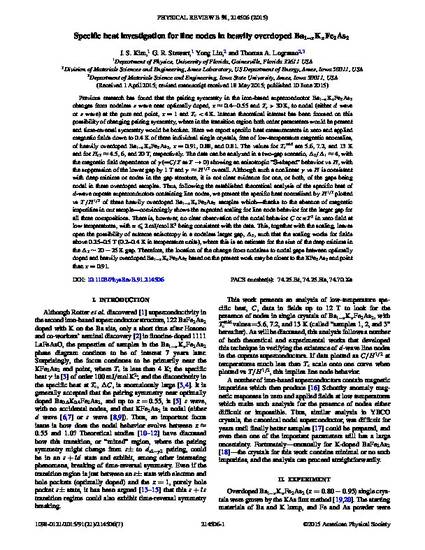
Article
Specific heat investigation for line nodes in heavily overdoped Ba1−xKxFe2As2
Physical Review B
Document Type
Article
Disciplines
Publication Version
Published Version
Publication Date
6-1-2015
DOI
10.1103/PhysRevB.91.214506
Abstract
Previous research has found that the pairing symmetry in the iron-based superconductor Ba1−xKxFe2As2 changes from nodeless s wave near optimally doped, x≈0.4−0.55 and Tc>30K, to nodal (either d wave or s wave) at the pure end point, x=1 and Tc<4K. Intense theoretical interest has been focused on this possibility of changing pairing symmetry, where in the transition region both order parameters would be present and time-reversal symmetry would be broken. Here we report specific heat measurements in zero and applied magnetic fields down to 0.4 K of three individual single crystals, free of low-temperature magnetic anomalies, of heavily overdoped Ba1−xKxFe2As2,x=0.91, 0.88, and 0.81. The values for Tcmid are 5.6, 7.2, and 13 K and for Hc2≈4.5, 6, and 20 T, respectively. The data can be analyzed in a two-gap scenario, Δ2/Δ1≈4, with the magnetic field dependence of γ(=C/TasT→0) showing an anisotropic “S-shaped” behavior vs H, with the suppression of the lower gap by 1 T and γ≈H1/2 overall. Although such a nonlinear γ vs H is consistent with deep minima or nodes in the gap structure, it is not clear evidence for one, or both, of the gaps being nodal in these overdoped samples. Thus, following the established theoretical analysis of the specific heat of d-wave cuprate superconductors containing line nodes, we present the specific heat normalized by H1/2 plotted vs T/H1/2 of these heavily overdoped Ba1−xKxFe2As2 samples which—thanks to the absence of magnetic impurities in our sample—convincingly shows the expected scaling for line node behavior for the larger gap for all three compositions. There is, however, no clear observation of the nodal behavior C∝αT2 in zero field at low temperatures, with α≤2mJ/molK3 being consistent with the data. This, together with the scaling, leaves open the possibility of extreme anisotropy in a nodeless larger gap, Δ2, such that the scaling works for fields above 0.25–0.5 T (0.2–0.4 K in temperature units), where this is an estimate for the size of the deep minima in the Δ2∼20−25K gap. Therefore, the location of the change from nodeless to nodal gaps between optimally doped and heavily overdoped Ba1−xKxFe2As2 based on the present work may be closer to the KFe2As2 end point than x=0.91.
Copyright Owner
American Physical Society
Copyright Date
2015
Language
en
File Format
application/pdf
Citation Information
J. S. Kim, G. R. Stewart, Yong Liu and Thomas A. Lograsso. "Specific heat investigation for line nodes in heavily overdoped Ba1−xKxFe2As2" Physical Review B Vol. 91 Iss. 21 (2015) p. 214506 Available at: http://works.bepress.com/thomas_lograsso/238/

This article is from Phys. Rev. B 91 (2015): 214506, doi:10.1103/PhysRevB.91.214506. Posted with permission.